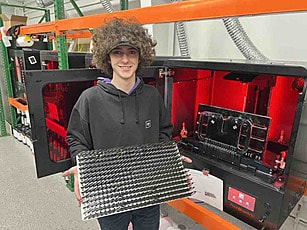Utah 3D printing service Merit3D has received an order for 1 million components from Adhesives Technology. The parts are being made—some 40,000 a week—on Photocentric printers using BASF Ultracur EPD 1006. Remarkably, the item is a rather quotidian one—not a space part nor an implant. No, this is a hanger that connects an epoxy tube to its nozzle. Adhesives Technology had some supply chain issues and, with a lead time of two weeks, Merit3D designed a 3D printed solution for them.
The 3D printing is being performed on a Photocentric Magna system and was later improved so that it could be used on many more epoxy tubes. Rather than go overseas, Adhesives Technology ordered a production run of 30,000 3D printed units. At 100,000 parts, the component was redesigned to be more cost-efficient. At 500,000, a further improvement was implemented. The company then went on to make 40,000 a week. At one point, the company obtained a Utah Manufacturers Modernization Grant for robotics and automation to reduce costs even further.
Merit3D CEO Spencer Loveless said of the project, “Manufacturing is undergoing a digital revolution, with companies – both large and small – embracing additive manufacturing,”
There are a lot of bridge manufacturing examples out there that we don’t often hear about. On cars and the like, some bridge parts have been printed which are in and of themselves cheap, but are attached to something expensive. GM’s example with Multi Jet Fusion is a case in point. In other cases, a 3D printed component could be low cost, but issues with its supply chain could block millions in revenue. Generally, first production runs may be performed with additive, but a company would tend to switch to molding later on.
In the case of this project from Merit3D, this is a remarkably low-value part, that is also not attached to a super expensive element, but is instead attached to a relatively low cost item. So this component could push the thinking of people in additive towards new more consumable parts. The unit is also very flat, while the additive manufacturing (AM) industry usually likes its parts more three dimensional and complex. Therefore, such an extensive run is also remarkable and a million parts total is amazing. There must have been a unique confluence of events to make this make sense for everyone.
All of this pays into Merit3D’s larger goal of reshoring jobs and production to its native Utah, where it is situated in the heart of coal country. Merit3D, or something very much like it, is the future. We will still have service bureaus for high-value parts and prototypes, but a new series of companies will emerge that will be able to make low-cost parts at high volume. We’ve written about this in 2021 and again more recently.
Alongside Merit3D is Slant3D, which is using desktop 3D printers for manufacturing, which you can hear more about from CEO Gabe Bentz in the 3DPOD episode below:
3DPOD Episode 139: 3D Printer Farms with Gabe Bentz, Slant 3D CEO
Gantri is using desktop machines to make lamps and other home décor, which you can learn more about from founder Ian Yang in the 3DPOD episode here:
3DPOD Episode 149: 3D Printed Consumer Goods with Ian Yang, Gantri Founder
These firms will be followed by many more, but there is more scope for completion. Using Formlabs machines, it would be possible to print custom hearing aids in a small store close to customers. With cheaper Phrozen machines, one could make molds for jewelry or other components. And machines such as those from Photocentric can clearly perform much bigger production runs still. It’s no surprise then that Formlabs has released automation tools for its machines or that Mosaic, in Canada, has developed a print farm solution. However, I really think we need more automation and QA tools, as well as software, to further assist these firm in making low-cost production with 3D printing a reality. I can’t wait to see more cases like this emerge!
